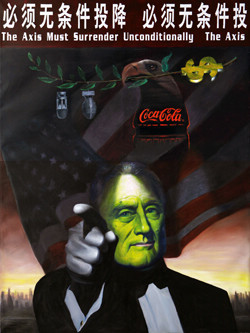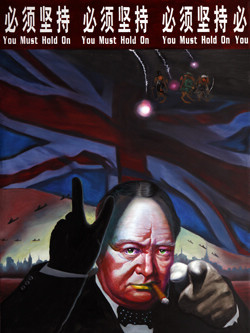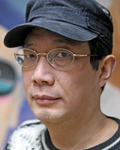|
 |
 |
|
RESOLUTE LEADER: U.S. President Franklin Roosevelt in the World War II series (COURTESY OF LIU YIGANG) |
VICTORY POSE: British Prime Minister Winston Churchill in the World War II series (COURTESY OF LIU YIGANG) |
 |
|
Liu Yigang | Liu Yigang, a 51-year-old artist, is making efforts to interpret history through painting portraits of well-known international figures. In one of his recent works, Liu painted a confident and strong-willed U.S. President Franklin Roosevelt. The image of Roosevelt was the symbol of the brave American people who fought against fascists during World War II. In the painting, Roosevelt's iron fist is pointing to his audiences, and he seems to warn the enemies that unconditional surrender is their only choice. Liu added some elements to the portrait of Roosevelt to enrich the symbolism. He painted a bald eagle, a bottle of Coca Cola, a U.S. dollar mark and atomic bombs behind Roosevelt to show the irresistible influence of U.S. pop culture, its powerful military and strong economy.
Liu has been painting an epic series of portraits titled New Illuminants, of which he has finished two groups, Centenary and World War II. Centenary is made up of paintings of Chinese leaders who played significant roles in modern Chinese history. The art works of World War II depict some wartime leaders of allied forces including U.S. President Franklin Roosevelt, U.K. Prime Minister Winston Churchill, and Soviet Union leader Joseph Stalin.
"People are becoming increasingly concerned with public figures due to the development of society in the global information age. Therefore, artists like me hope to find special ways to interpret public topics. That is why I did portraits of some well-known leaders," Liu said.
"Furthermore, many of the political figures I portrayed are well-known internationally. Their stories tell an important period of history. But their images in the hearts of the people may vary—who is good or who is bad. What I want to do is to paint those politicians according to my own understanding of history," said Liu.
"I want to paint them in a pop art way. I add post-modern characteristics to the epic style of painting and try to make the paintings more appealing to younger generations," Liu said.
Exaggerated use of colors on the faces of the leaders, such as red, green, yellow and blue, implies different mental activities of each figure. Liu also writes slogans on top of the portraits to support the symbolism.
A common feature of the portraits is the light beam on each leader's face. Liu believes that great political leaders are like the light of hope, giving direction for people lost in the dark world. However, Liu explained, the light could only help lead people out of the darkness. It is the successor who should continue the peace-keeping efforts when the predecessor's time is over.
Liu studied at Sichuan Fine Arts Institute in Chongqing City in southwest China. Later, he entered the Central Academy of Arts and Crafts, which was merged with Tsinghua University and renamed the Academy of Arts & Design of Tsinghua University in 1999, for further study. He majored in sculpture and decorative design. After graduation in 1987, he worked as a sculptor and designer for a state-owned enterprise in Beijing.
|
